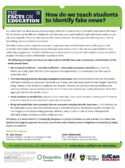How do we teach students to identify fake news?
In a world where it is increasingly dangerous to simply trust what we read and see
In a “post-truth” era where people are increasingly influenced by their emotions and beliefs over factual information, fact and fiction can be difficult to distinguish, and fake news can spread rapidly through mainstream media sources and social networks. Moreover, fake news is often meant to do harm, by tricking us into believing a lie or unfairly discrediting a person or political movement.
Given this malicious intent, students must learn to approach news and information with a critical eye in order to identify intentionally misleading sources (although recent studies confirm that this is an uphill battle for both adults and young people). Teachers therefore play a crucial role in ensuring that their students develop the skills to decipher the many streams of information available to them.
The following strategies and ideas can help students identify fake news and become critical readers of the world around them :
- Move beyond traditional – and often ineffective – information evaluation checklists (e.g. RADCAP, CRAAP, and CARS), which fall short when applied to the sophisticated tools and techniques often used to create fake news.
- Prioritize helping students develop investigative techniques where they become familiar with information verification websites (e.g. FactsCan, org, Snopes, and Hoax Slayer) and tools like Google’s “search by image” feature or the VerificationHandbook.com resource. Students can also learn about professional fact checking strategies such as reading laterally, which involves cross-referencing a variety of websites rather than digging further into the website at hand.
- Teach students to identify bias using tools like a media bias chart, which provides a starting point for them to understand that all sources come from a particular perspective.
- Bring real-world fake news examples that we encounter everyday into the classroom so that students can be challenged to apply their skills and techniques to authentic situations, like determining the true origin of a viral image or video and examining potential catfishers, bots, or trolls in order to better understand the hallmarks of fake and malicious social media accounts.
Ultimately, in a world where it is increasingly dangerous to simply trust what we read and see, it is critical that students are taught to approach the world around them with a healthy sense of skepticism to avoid being misled, duped, or scammed.
Additional Information Resources
Information Verification Websites
- FactsCan
- Factcheck.org
- Snopes
- Hoax Slayer
- VerificationHandbook.com
- Google’s “search by image” feature
Sample Media Bias Chart
Other Practical Resources
- Web Literacy for Student Fact-Checkers
- KQED Lesson plans
- 5 Ways to Spot Fake News – Video and article from Common Sense Media
- What’s News: Fake, False, Misleading, Clickbait, Satire, or Carefully Reported?
- The Smell Test: Educators can counter fake news with information literacy. Here’s how.
- Fake News: A Library Resource Round-up
- Dynamic Landscapes – Resources List
- NewseumED unit on media literacy
- The News Literacy Project
References
For definition of “post-truth,” please see: Collins English Dictionary. “Definition of ‘post-truth.’” HarperCollins Publishers. Accessible from www.collinsdictionary.com/dictionary/english/post-truth
Wineburg, Sam and McGrew, Sarah and Breakstone, Joel and Ortega, Teresa. (2016). “Evaluating Information: The Cornerstone of Civic Online Reasoning.” Stanford Digital Repository. Accesible from http://purl.stanford.edu/fv751yt5934
Mitchell, A., Gottfried, J., Barthel, M., Sumida, N. (June 18, 2018). “Distinguishing Between Factual and Opinion Statements in the News.” Pew Research Center. Accessible from www.journalism.org/2018/06/18/distinguishing-between-factual-and-opinion-statements-in-the-news/
National Council of Teachers of English (February 2013). “NCTE Framework for 21st Century Curriculum and Assessment.”. Accessible from www.ncte.org/governance/21stcenturyframework
Domonoske, C. (June 19, 2018). “It’s Easier To Call A Fact A Fact When It’s One You Like, Study Finds.” National Public Radio. Accessible from www.npr.org/2018/06/19/621569425/its-easier-to-call-a-fact-a-fact-when-it-s-a-fact-you-like-study-finds



